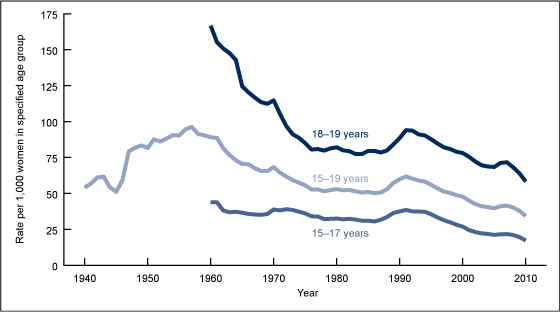This is long and parts of it are mathy. Consider yourself warned.
Yesterday, I heard a report on my local NPR affiliate, WUOT, regarding teen pregnancy in the US and the states individually. Tennessee is 10th in the nation in the rate of teen pregnancy, and I'd say most people around this area would find that to be a disturbing statistic.
But it is down 19% from three years ago. The national rate is down 17% in those three years. The trend looks like this:

Forty-seven states saw a statistically significant decline in teen pregnancy rates between 2007 and 2010. Tennessee's 19 percent decline wasn't even in the top 16 states. Only West Virginia, Montana, and North Dakota didn't see significant declines in that time period.
The raw number-- not as a percentage-- is the lowest it has been since 1946, when the US population was less than half what it is now. As a percentage, it is the lowest in the modern era, as you can see in the graph. It is undeniable that considerable progress has been made in this area, and we should all be happy about that.
That's all good news! However . . .
WARNING: Statistics to follow
You know I can't let this go without a little deeper analysis. So I took the state-by-state 2010 data and added it to an existing data set I already had that contained average IQ, religiosity, % minority, and per capita income. I ran a quick variable selection and came up with a model that fits surprisingly well and doesn't have any serious statistical issues. The model looks like this:
StateTeenPregRate=0.44*Religiosity - 1.52*AvgIQ - 0.0004*Income + 172.61
Religiosity and AvgIQ are both highly significant (p-value<0.0001). Income is less so but I left it in the model so that the others are adjusted for it-- without that there would be reasonable criticism of the model's validity. R-squared is 0.7451, meaning ~75% of the state-to-state variation in teen pregnancy rates can be explained using this model. For those of you not terribly familiar with multiple regression, this R-squared is HIGH. This model has a lot of explanatory power.
The intercept is pretty meaningless in this model but let's take a look at the other coefficients:
** For each 1 percentage point increase in religiosity (percent of population that claims to be religious or highly religious), on average the state has a teen pregnancy rate that is 0.44 (pregnancies per 1000 teens) HIGHER. This means that on average and adjusting for IQ and income, a state that is 70% religious will have a teen pregnancy rate that is about 4.4 pregnancies per 1000 higher than a state that is 60% religious.
** For each 1 point increase in average IQ, on average the state has a teen pregnancy rate that is 1.52 (pregnancies per 1000) LOWER. This means that on average and adjusting for religiosity and income, a state with an average IQ of 105 would have a teen pregnancy rate that is about 15.2 pregnancies per 1000 lower than a state with an average IQ of 95.
** For each $1 increase in per capita income, on average the state has a teen pregnancy rate that is 0.0004 (pregnancies per 1000) LOWER. This means that on average and adjusting for religiosity and IQ, a state with a per capita income of $45,000 would have a teen pregnancy rate that is about 4 pregnancies per 1000 lower than a state with a per capita income of $35,000.
It shouldn't surprise anyone that smarter, richer populations would have lower teen pregnancy rates. I consider both of these to be control variables because they are obvious and expected.
So that leaves religiosity, which turned out to be the most significant variable in the model. By itself, it's also the best 1-variable determinant of teen pregnancy (r-squared=0.561), with a stronger relationship than IQ and a much stronger relationship than income.
End of painful statistical analysis. Begin non-statistical interpretation. Obligatory statement on correlation not implying cause, etc.
I doubt that the religious are having more premarital sex than the less- or non-religious-- at worst maybe it's equal-- so what gives? I'm all ears for other explanations, but I think this one is pretty easy:
It's sex education and the knowledge and availability of contraception. The increase in these things has much to do with the rapid national decline in teen pregnancy in recent decades. It's why nearly every state is seeing a decline, no matter how high or low its initial rate.
So who has been fighting the advocacy and availability of contraception to teenage Americans, and who has been fighting sex education? Conservative Christian groups, who are larger and have more influence in the states with higher religiosity. I really think it is that simple.
To me this is a serious blow to any argument that abstinence-only sex education can work. Not only are teens, by and large, NOT abstinent in any state, but those where abstinence is pushed harder over contraception have the highest rates of teen pregnancy, and the relationship is highly statistically significant. They are having sex-- they just aren't protecting themselves. The result is teen pregnancy at higher rates.
I'll hold off on any more discussion and let someone else chime in-- especially as this relates to conservative political leaders like Rick Santorum and religious authorities in the catholic and evangelical churches. My first reaction when contraception came up in the campaign was that it was ridiculous to even be discussed-- but instead I think it should have been alarming and enlightening.

